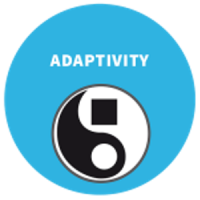Complex, Meidoornkade 22
3992 AE Houten
0343 528 040
3992 AE Houten
0343 528 040

New situations might require another approach. Both as a person and a a group we need ‘to make a new path’ of thinking and doing. That an a healthy interaction between people facilitates the group flexibility and its ability to adapt to unforeseen situations and events.
The success strategy: Think big & act agile. When needed we facilitate a well-balanced change of underlying systems, structures and mindsets. We can discuss this factor using the following success markers: Energized, Resources, Healthy balance, Agility and Optimal control

In most cases professionals feel energized during the interaction with other team members. This differs depending on the social cohesion in a team. In many cases social interaction stimulates and motivates. (Source: Ruysdael research on connected leadership)
Find situations, people, places and joint activitities that engerize you. Also find time that you spent alone. It is all about a porper dynamic balance.
In case you expect a meeting to drain your energy expand your own behaviour pattern:
Discuss and explore the cause of meetings which drain the energy.
Find a rhythm and flow of interaction by:
Find the win-win-win (Franklin Covey)
Stand-up meetings (Lean)
Alternate a work and play attitude

38% of the team members feel that resources are or will be insufficient to reach the common goal. 25% is convinced that resources will be sufficient. These survey results seem an explanation for the relatively high number of teammembers that lack intiative. It also explains why many feel an inbalance between expectations and reality. (Source: Ruysdael research on connected leadership)
Reflect on your current situation and activate a resourceful mindset:
Team resources such as motivation, focus and human energy could be activated by reflecting on these questions:
Brainstorm meeting (Problem solving or creative search)
Retrospective (Agile)
Align with other stakeholders what resources are needed en negotiate timely delivery.
Descope timelines and objectives when resources are not available.

Improve self-awereness and your perception of reality.
In case you experience frustration, cynism or a feeling of uncertainty, use these questions to create a better balance between expectations and reality.
The right level of expectation creates a compelling future and stimulates team action. Discuss expectations to obtain an joint perspective of
Make sure that transparency among all participants is high by frequent interaction, alignment en communication.
Conduct a stakeholder analysis.
Convert important expectations into mutual agreements.

Agility at a personal level is all about options. It requires flexibility in the way your respond to your environment. Increase your flexibility by:
How would you classify the way your team responds to new information and settings? Proactive or reactive? Reactive teams change their behavior after the environment has changed. Proactive teams visualize the future, define possible scenario’s and influence the environment to prevent changes or to adapt before the change occurs. These questions help a team to a more proactive approach:
Or check out other success markers:

Optimal control is all about finding the right dynamics of autonomy and alignment. It starts with being aware of three levels of control:
And finding mutual agreements concerning:
control (execute while being directed).
Control is a cybernetic feedback loop between all people and departments that are involved in reaching the collective objective. Optimal control requires a collective context and a shared vision on how to ‘control’ the outcome.
Project settings: Determine tolerances.
Agile settings: Work with ‘sprints’ and ‘product backlog’.
Rien van Leeuwen gaat in op basiscondities voor duurzame verandering.
Aan de hand van praktijk-cases verkennen we de barrières bij het bereiken van duurzame doelen op strategisch, tactisch en operationeel niveau. Denk hierbij aan bestaande structuren en opvattingen, maar ook aan het niet kunnen duiden van negatieve en positieve impact.
We delen onderling de best practices en interventies die anderen activeren. Uiteindelijk draait elke verandering om een andere manier van interactie.
Rien van Leeuwen gaat in op basiscondities voor duurzame verandering.
Aan de hand van praktijk-cases verkennen we de barrières bij het bereiken van duurzame doelen op strategisch, tactisch en operationeel niveau. Denk hierbij aan bestaande structuren en opvattingen, maar ook aan het niet kunnen duiden van negatieve en positieve impact.
We delen onderling de best practices en interventies die anderen activeren. Uiteindelijk draait elke verandering om een andere manier van interactie.